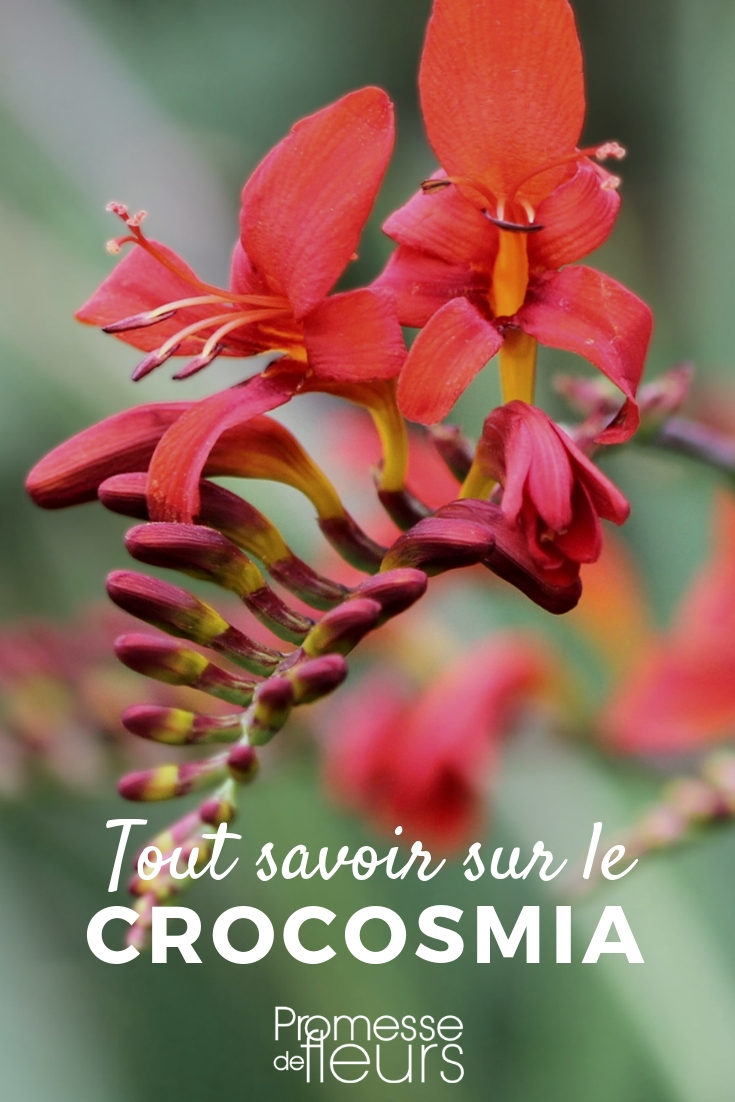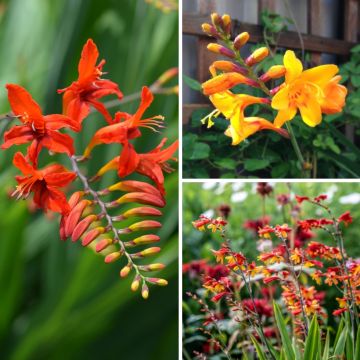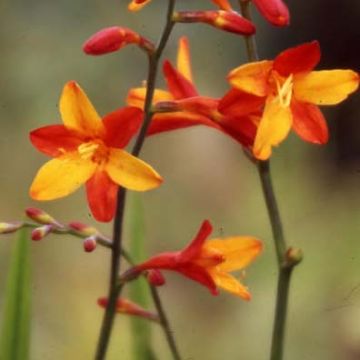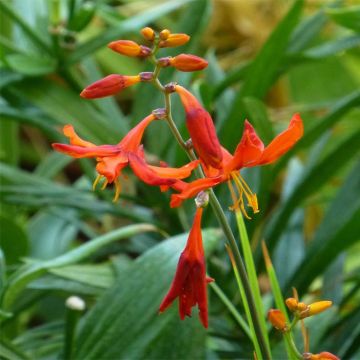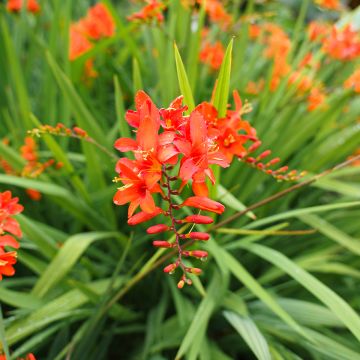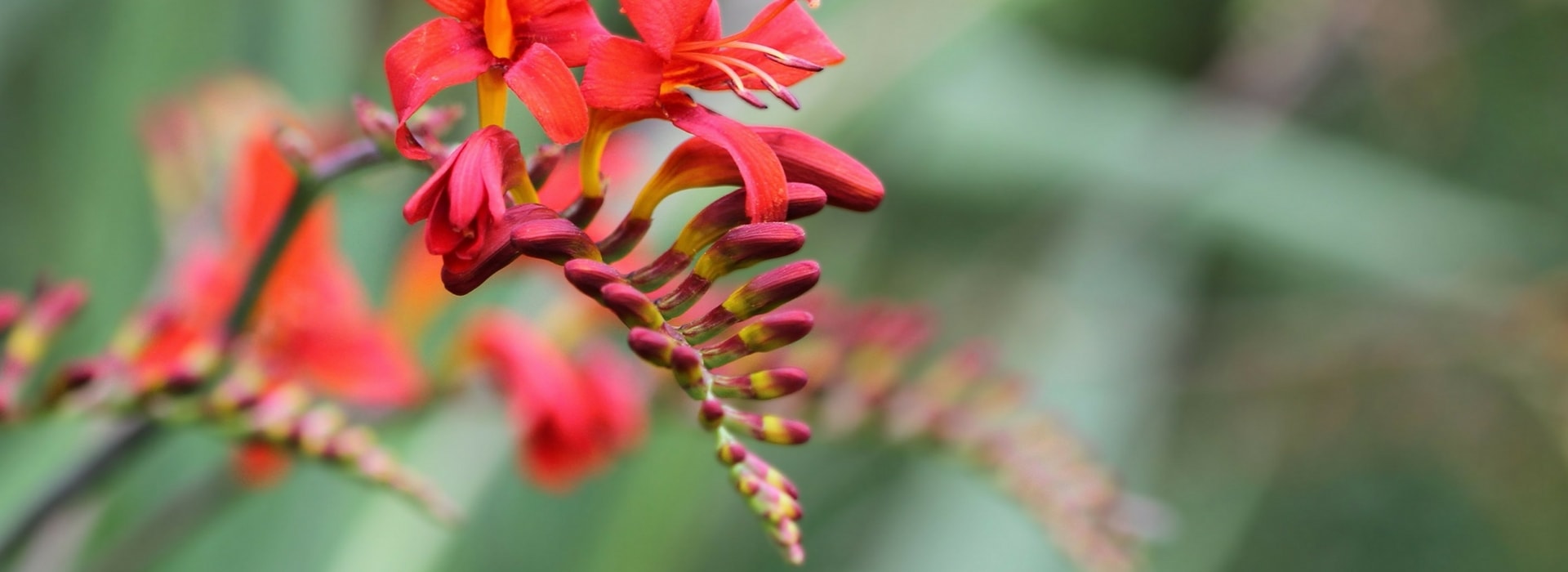
Crocosmia, montbretia: planting, cultivation and maintenance
Contents
Crocosmia, in a nutshell
- With its false resemblance to gladiolus, the Crocosmia offers a beautiful palette of warm colours: from the intense red of Crocosmia ‘Lucifer’ to the bright yellow of the variety ‘Columbus’, not forgetting the vibrant orange flowers of Crocosmia masoniorum! There are even bi-coloured varieties, such as ‘Emily McKenzie’ with its orange and red flowering.
- Easy to grow, and not very susceptible to diseases and pests, this flowering bulb will settle in easily if you place it in the sun and in well-drained soil.
- With its intense colours, the long summer flowering of Crocosmias will bring a touch of exoticism and dynamism to sunny borders.
- Its very slender, decorative foliage and graphic habit will add a lot of lightness and volume to your garden.
- With good vase life, it is perfect for creating stunning bouquets.
A word from our Expert
Crocosmia, or Montbretia, resembles a small gladiolus but with its vibrant colours, it is an excellent plant to bring dynamism and cheerfulness to your borders. Crocosmia ‘Lucifer’ is undoubtedly the most popular, with its fiery red flowers. This superb flowering bulb of South African origin will charm you with its intense flowering and its bright green, upright and decorative foliage.
Some hybrids, such as Crocosmia x crocosmiiflora, come in a wide range of warm colours, with several hundred varieties available. You will easily find one that suits you. It is a very good border plant that pairs well with annuals or perennials with bright flowers, for a garden full of colour!
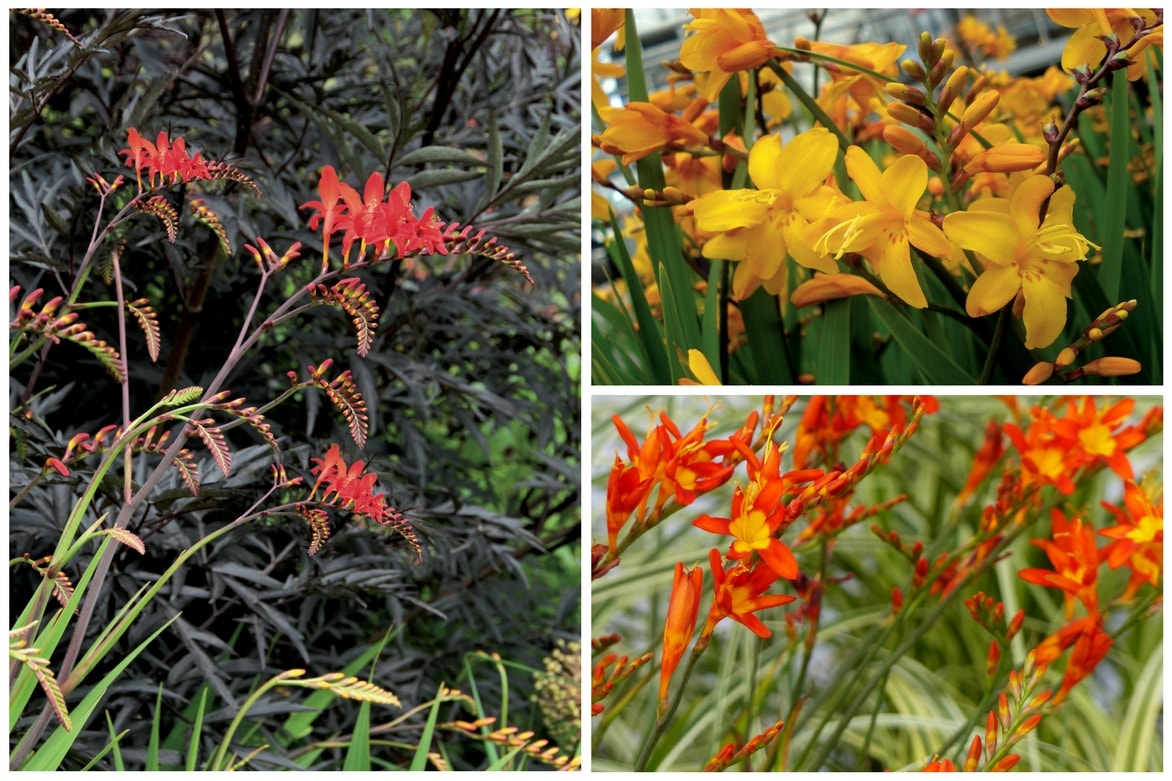
Crocosmia ‘Lucifer’ – Crocosmia ‘Columbus’ – Crocosmia (bicoloured flower variety)
Of fairly easy cultivation, Crocosmia mainly needs a sunny location and well-drained soil that remains cool in summer. It is not very susceptible to diseases and pests and requires little maintenance. Once established, it spreads easily by producing stolons and new bulbs. Moderately hardy, it needs to be mulched to survive winter.
It is also a lovely cut flower, ideal for making bouquets. Under good conditions, it can last up to two weeks in a vase.
Botany
Botanical data
- Latin name Crocosmia sp.
- Family Iridaceae
- Common name Crocosmia or Montbretia
- Flowering July to October
- Height 60 cm to 1.20 m
- Exposure full sun, tolerates light partial shade
- Soil type cool, well-drained
- Hardiness -5 °C to -10 °C depending on the species, and down to -15 °C for Crocosmia masoniorum
Crocosmias grow wild in the meadows on the eastern coast of South Africa. There are nine species, all native to South Africa except for one, Crocosmia ambongensis, which is endemic to Madagascar. Horticulturists have created over 400 varieties of Crocosmia.
This plant derives its name from the Greek krokos: saffron, and osme: smell, because when the flowers are placed in hot water, they emit a strong scent of saffron. Crocosmias are often known by the common name Montbretia, which specifically refers to hybrid Crocosmias, particularly Crocosmia x crocosmiiflora.
The Crocosmia belongs to the large family of Iridaceae, which includes 1,800 species of predominantly herbaceous plants. This cosmopolitan family (found on all continents) also includes Gladiolus and Iris. These are generally geophytes, disappearing in autumn to spend the winter buried in the soil thanks to storage organs (bulbs, corms…).
They reappear in spring. The Crocosmia is very close to Tritonia, a genus that was formerly used as a synonym for Crocosmia.
Montbretia has a erect habit and forms a clump. It grows quickly and typically reaches 60 cm in height. The largest varieties, such as ‘Lucifer’, can even measure up to 1.20 m! It spreads easily through stolons, small horizontal stems that root upon contact with the soil to create new clumps. However, patience is required for your plant to form a dense clump.
At the centre of the clump rise long arching flower spikes, bearing terminal inflorescences composed of about twenty flowers. These are tubular, arranged horizontally and in two rows. They take on shades ranging from deep red (‘Lucifer’) to yellow (‘George Davison’ or ‘Columbus’), passing through various shades of orange. Some varieties, like ‘Emily McKenzie’, are even bicoloured.
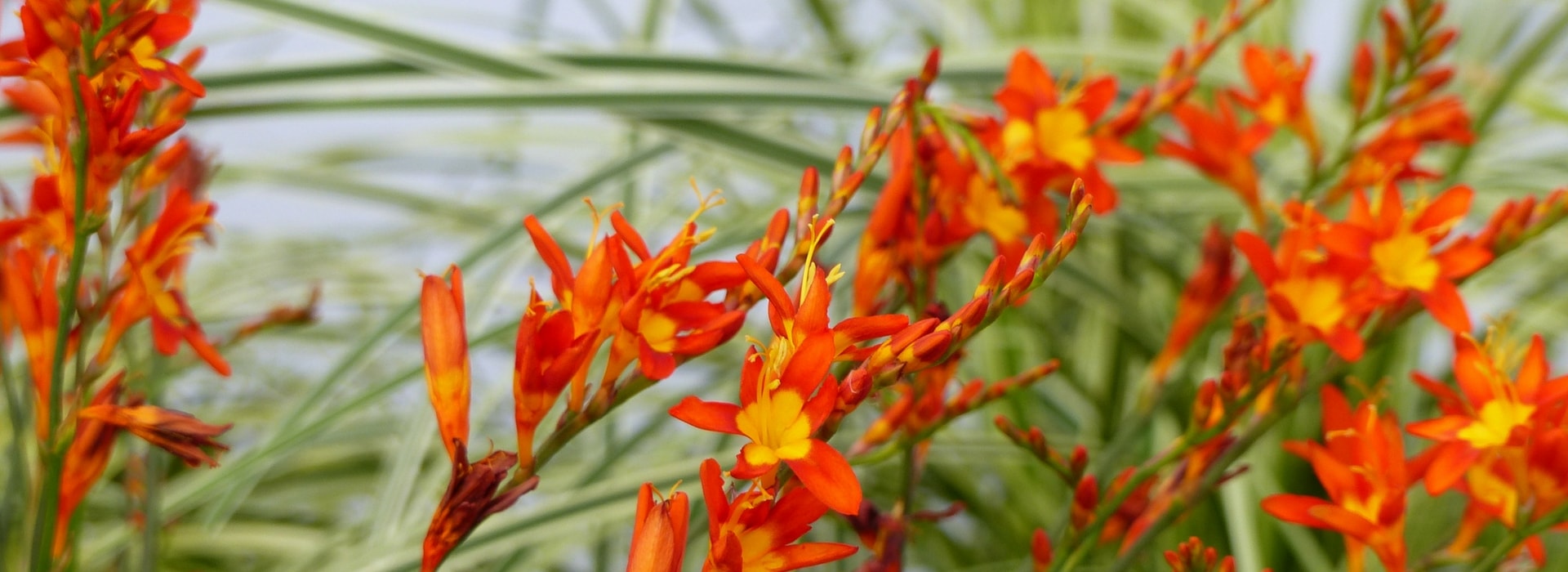
The Crocosmia offers a long summer flowering period, from July until September – October. The flower measures about 3 cm in diameter and 2.5 cm in length. It is composed of six petals arranged in two rows (three inner and three outer). At the centre emerge three long stamens, all of equal length. These flowers are melliferous and attract butterflies.
It has very beautiful deep green leaves, erect and elongated in lance shape. These leaves are arranged alternately on the stem (one leaf after another). They resemble those of gladioli, which are also long and plicate lengthwise. They can measure up to one metre long and 3 cm wide. The foliage is deciduous: it dries in autumn and reappears in spring.
In autumn, to survive the harsh season, the plant forms corms, a type of rounded and flattened bulb. They allow the plant to store reserves and restart in spring. It is a swollen stem, protected by small scales.
These corms grow in a chain, one above the other. There can be up to ten in succession. The new corms are located at the top, while the older ones are buried deeper. Beneath these lower corms, the plant has roots that allow it to sink a little deeper. The corms separate easily from one another, facilitating the plant’s propagation (each corm can form a new plant).
The fruits of the Crocosmia consist of three-lobed capsules, measuring up to 1 cm long. They contain small brown seeds. They are decorative due to their graphic appearance, resembling beads hanging on the stems.

Crocosmia: botanical aspects
Montbretias are moderately hardy. Some very resilient varieties (like Crocosmia masoniorum) can withstand temperatures down to -15 °C. However, on average, they can tolerate temperatures of -10 °C, provided they are protected by mulching. We recommend taking action in autumn to protect the bulbs by placing a thick layer of dead leaves, for example, or by digging them up to keep them safe during winter.
The variety Crocosmia x crocosmiiflora is a hybrid obtained around 1880 by the French nurseryman Victor Lemoine, by cross-breeding the species Crocosmia aurea and Crocosmia pottsii. Cultivated worldwide, this hybrid has become invasive in California, New Zealand, the UK, Australia, Réunion…
The Crocosmia enjoys maritime climates that are relatively mild and humid. In France, it thrives along the Atlantic coast, particularly in Brittany and Normandy.
Read also
Planting CrocosmiasSpecies and varieties
Il existe nine species of Crocosmia, and over 400 varieties created by horticulturists. Most of these varieties are obtained from Crocosmia x crocosmiiflora, which results from a cross-breeding between Crocosmia aurea and Crocosmia pottsii.
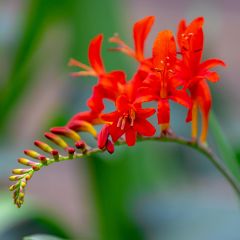
Crocosmia Lucifer - Montbretia
- Flowering time August to October
- Height at maturity 1 m
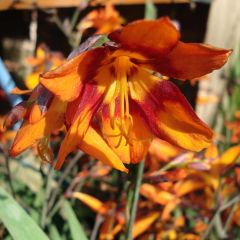
Crocosmia Emily McKenzie - Montbretia
- Flowering time August to October
- Height at maturity 60 cm
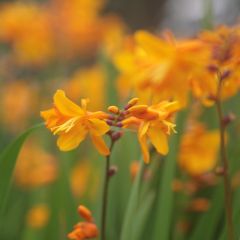
Crocosmia Columbus - Montbretia
- Flowering time August to October
- Height at maturity 50 cm

Crocosmia Carmine Brillant - Montbretia
- Flowering time August to October
- Height at maturity 70 cm
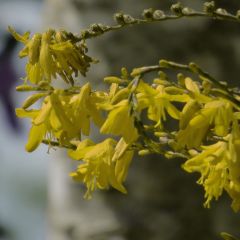
Crocosmia Solfatare - Montbretia
- Flowering time August, September
- Height at maturity 60 cm

Crocosmia George Davison - Montbretia
- Flowering time August to October
- Height at maturity 45 cm
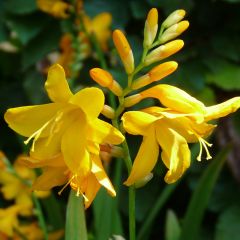
Crocosmia Buttercup - Montbretia
- Flowering time August to October
- Height at maturity 60 cm
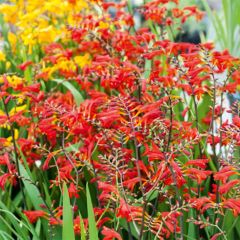
Crocosmia Emberglow - Montbretia
- Flowering time August to October
- Height at maturity 60 cm
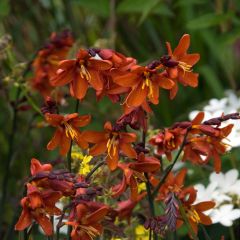
Crocosmia Dusky Maiden- Montbretia
- Flowering time February
- Height at maturity 40 cm
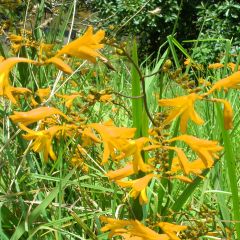
Crocosmia Norwich Canary - Montbretia
- Flowering time August to October
- Height at maturity 60 cm
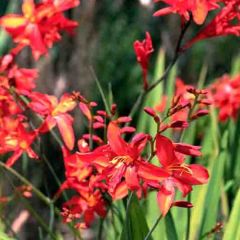
Crocosmia Zeal Tan - Montbretia
- Flowering time August, September
- Height at maturity 60 cm
These species exist in the wild, mainly in South Africa. They can be more difficult to obtain than horticultural varieties, except for Crocosmia masoniorum, which is quite common in cultivation.
- Crocosmia masoniorum
With its bright orange flowers, it is undoubtedly the most beautiful of the botanical species of Crocosmia. It reaches a height of 80 cm. Easy to cultivate, it is also more robust and hardy than other varieties, and can thus withstand temperatures down to -15 °C. It is named after the American botanist Herbert Louis Mason (1896-1994). It originates from the mountainous areas on the East Coast of South Africa (Eastern Cape). Its distribution range is quite limited, making it rare in the wild.
- Crocosmia paniculata
This species reaches 1.20 m to 1.50 m in height and offers beautiful orange-red flowers, 6 cm long, borne on branched stems. Its leaves are strongly plicate and bright green in colour.
- Crocosmia aurea
This species is common in the meadows of the Cape floral region in South Africa. It can be found from South Africa to Sudan. It can reach 1.20 m in height. It flowers in branched inflorescences, each bearing up to ten large bright orange flowers, 4 cm in diameter. Its lanceolate leaves measure 2 to 3 cm in width.
- Crocosmia pottsii
This species can reach 80 cm to 1 m in height. Its inflorescences bear up to 30 small orange flowers.
Discover other Crocosmia
View all →Available in 0 sizes
Available in 2 sizes
Available in 3 sizes
Available in 1 sizes
Available in 1 sizes
Available in 1 sizes
Available in 3 sizes
Available in 2 sizes
Available in 1 sizes
Young plantation
Where to plant?
Crocosmia thrives in full sun, which is where it will flourish most easily. However, it can also tolerate partial shade. Feel free to plant it at the base of a south-facing wall.
Crocosmia prefers slightly acidic soils, but it also grows very well in neutral soil.
It enjoys cool ground that does not dry out in summer, and it will be happy if you place it near a pond. Just be sure to drain the soil with sand or gravel. It appreciates airy and light soils. To protect its corms from the risk of rotting, avoid water stagnation in winter!
You can also plant it in a pot, as a solitary specimen, or combine it with perennials or grasses. Ensure you use a sufficiently large container, place gravel at the bottom for drainage, and plant it in a mix of potting soil, garden soil, and sand.
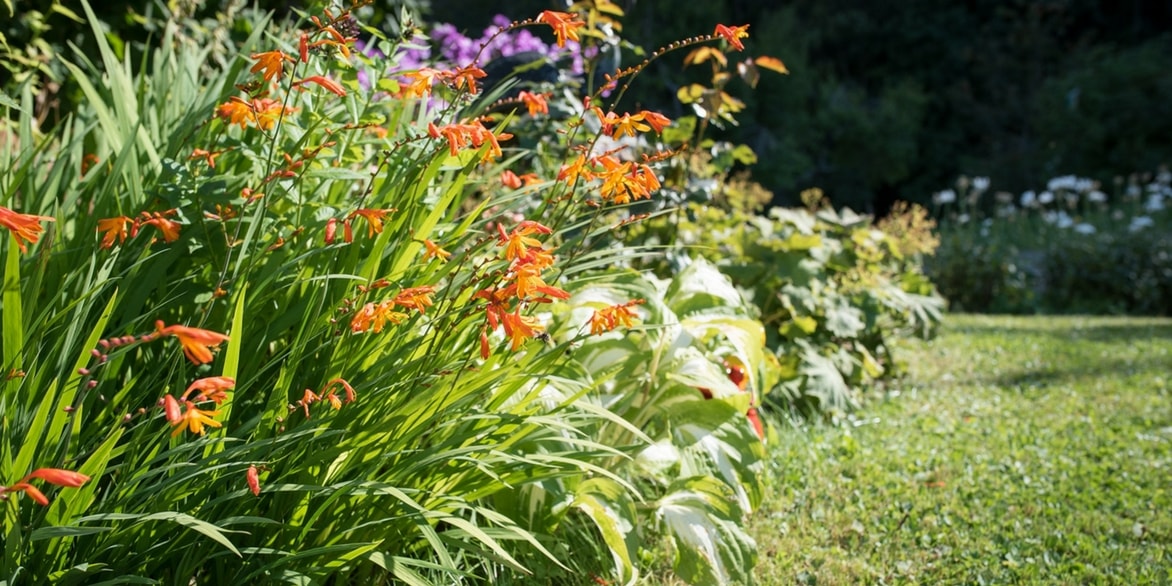
Crocosmia in a mass
When to plant?
The ideal planting period is in spring, in April-May, when there is no longer a risk of frost.
How to plant?
Corms are planted in the same way as bulbs. Start by working the soil to a depth of 15-20 cm. As Crocosmia enjoys rich soils, you can add compost or fertiliser. To facilitate drainage, add sand, especially if your soil is heavy and clayey. Then bury the bulbs 8-10 cm deep (and up to 15 cm for the coldest regions), ensuring the pointed end is facing upwards. Maintain a distance of 10 cm between each bulb so they have enough space to develop properly. We recommend planting them in groups to create a more beautiful effect. Feel free to group about ten corms in the same bed. Cover them with soil and water generously.
Maintenance and care
Once established, Crocosmia requires very little maintenance. Indeed, it is not very demanding and does not suffer from specific diseases or pests. You just need to ensure that you maintain a moist soil and protect it from the cold during winter, as Crocosmia is moderately hardy.
The roots of Crocosmia allow it to burrow deeper into the soil, making it increasingly resistant to frost over time! The first winter is therefore the most delicate to get through, so do not hesitate to protect the plant in one of the following ways:
- If temperatures do not drop below –5 °C (or if you have chosen a hardy variety! such as Crocosmia masoniorum…), simply apply a thick layer of mulch made of fallen leaves at the base. Additionally, in autumn, when the foliage is dry, we recommend leaving it in place to protect the stump during winter, rather than cutting it back for aesthetic reasons.
- If you live in an area where the cold penetrates deeply throughout winter, it is wise to dig up the bulbs in autumn to protect them from frost. Place them in a dry, dark, and well-ventilated location, sheltered from moisture to prevent them from deteriorating. Check them regularly as they may be gnawed by rodents or rot due to humidity. You can replant them in spring, as soon as the risk of frost has passed.
Crocosmia despises summer drought: the soil must remain moist, even in the height of summer. To prevent the soil from drying out too much and thus limit watering, we recommend protecting it with a layer of mulch. In any case, if you have planted Crocosmia in a pot, regular watering is essential. We suggest watering every ten days during the growth period, if the weather is dry.
To prolong the flowering, we recommend regularly removing faded flowers. This will encourage the arrival of new ones.
Multiplication
Crocosmia is easy to multiply. It regularly produces new corms, which you can collect to obtain new young plants. If you do not cut off the faded flowers, Crocosmia will tend to self-seed. You can collect the seeds and sow them, but they will not produce plants identical to the original variety. Additionally, by sowing, you will have to wait a long time before obtaining a sufficiently large clump. That is why we recommend buying the bulbs or dividing them from your existing plants.
Sowing
In autumn, once the seeds are harvested, you can sow them in pots or trays, under cover. The operation is quite simple. Place the seeds in a tray filled with previously moistened substrate. Cover with soil. Crocosmias can take 3 to 8 weeks to germinate. The substrate must remain moist until the plant germinates. In spring, when frosts are no longer a concern, you can plant them in the ground. You will then have to wait 2 to 3 years for the plant to flower.
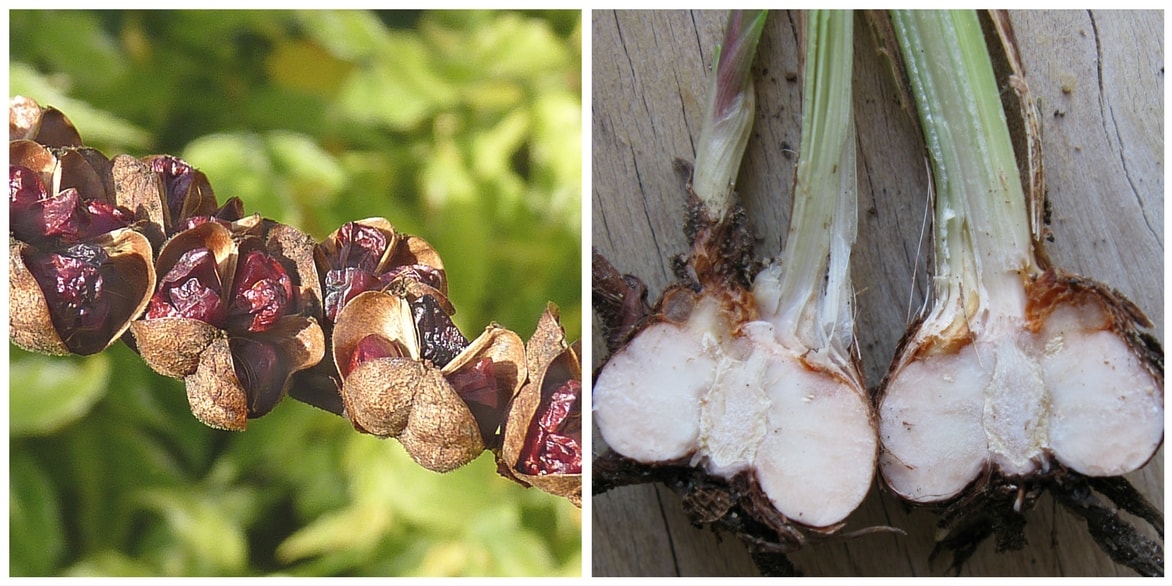 Seeds and cutting of a corm
Seeds and cutting of a corm
Division of corms
You can divide the corms in early spring, in March-April, before the plant begins its growth. This operation can be performed every three years and helps prevent the young plants from becoming too crowded.
Crocosmias regularly form runners, from which new corms grow, one above the other. Dig wide enough around the plant to avoid damaging the runners and corms. Dig up the stump and collect the new corms around the original plant. It is better to leave each group of corms intact rather than separating them with a knife: the oldest can thus serve as a nutrient reserve to promote the growth of the younger corms. Replant the new groups of corms in a suitable location.
Conversely, if you wish to limit the vigour of Crocosmias that may become too large, separate the corms using a sharp knife. Preferably keep the younger ones, those located on top. You can either discard the ones below (the oldest) or keep each corm to obtain a large number of young plants. Then replant and water.
Association
By its vivid and generous flowering, Crocosmia is a beautiful plant to integrate into a mixed-border in the English style. It will bring a touch of exoticism to your flowerbeds. Pair it with other blooms in yellow-orange-red tones to create a flowerbed rich in colours! Rudbeckias, Gaillardes, or Monardes will accompany it wonderfully! The red varieties are particularly suited to large gardens. They help draw the eye to a point in the garden and serve as a marker to guide the visitor…
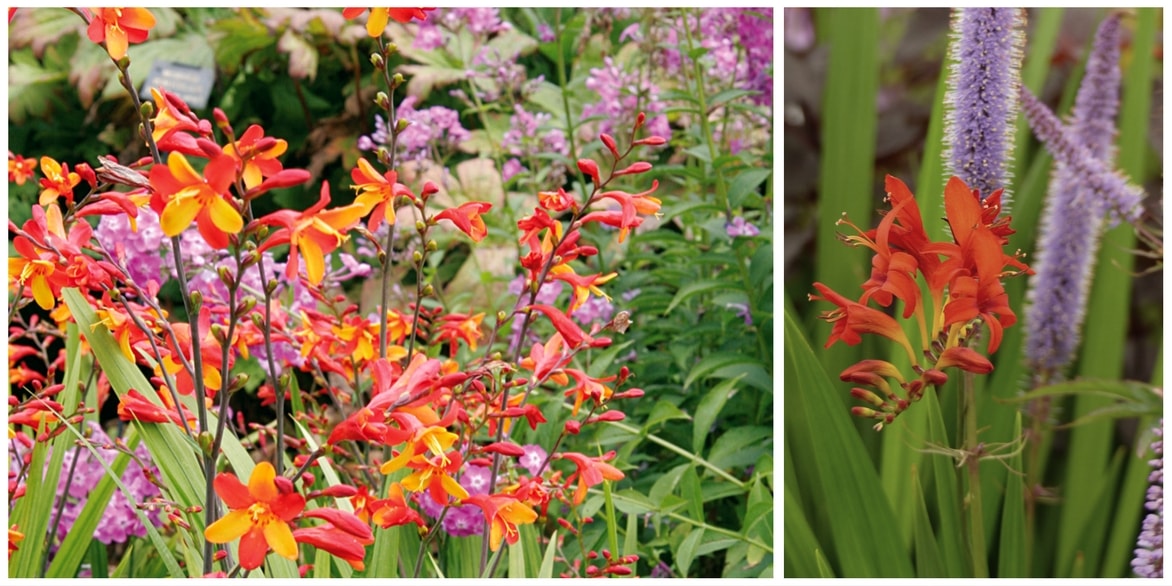
Crocosmia ‘Jackanapes’ and Phlox – Crocosmia ‘Lucifer’ and Veronicastrum virginicum ‘Fascination’
The slender leaves and airy flowering of Crocosmia make it quite graphic and allow it to add volume to a flat flowerbed or formal lines. It can thus create a beautiful contrast next to plants trimmed in a stricter manner. You can also pair it with plants that have white flowers, which will soften the bright colours of Crocosmia.
To discover more pairing ideas, check our advice sheet: Crocosmia – 9 successful pairing ideas.
Useful resources
- Our wide range of Crocosmias
- Also discover the Chasmanthes!
- Subscribe!
- Contents
